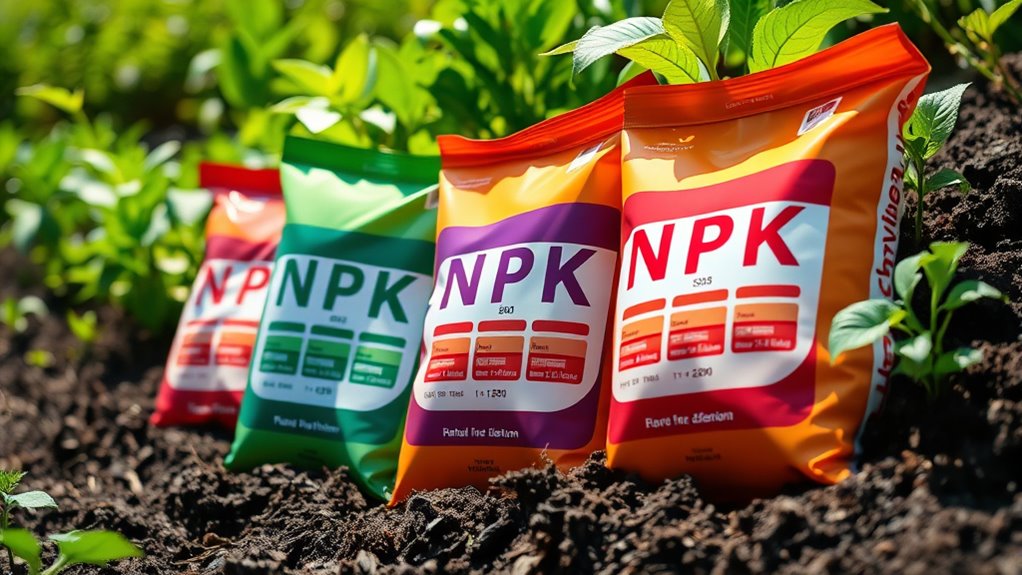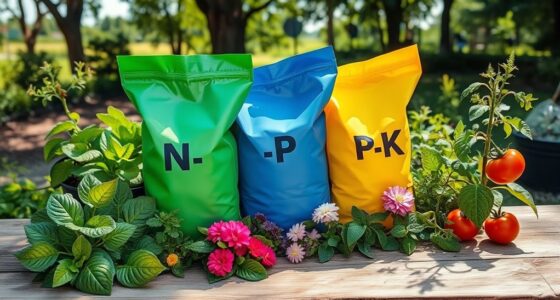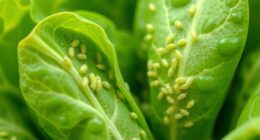Understanding N-P-K is key to providing your plants with the right nutrients. N (Nitrogen) promotes lush, leafy growth, while P (Phosphorus) supports healthy roots and flowers. K (Potassium) boosts disease resistance and drought tolerance. Check your fertilizer labels carefully to match your plants’ needs at different growth stages. Using the right balance prevents over-fertilizing and helps your plants thrive. Keep exploring to learn how to optimize your fertilization for healthier, more productive plants.
Key Takeaways
- N-P-K ratios on fertilizer labels indicate the levels of Nitrogen, Phosphorus, and Potassium, essential nutrients for plant growth.
- Different plants and growth stages require specific nutrient balances; leafy greens need more nitrogen, flowering plants need more phosphorus and potassium.
- Nitrogen promotes leafy, vegetative growth; phosphorus supports root development and flowering; potassium enhances disease resistance and drought tolerance.
- Organic fertilizers release nutrients gradually, supporting sustainable gardening and reducing environmental impact.
- Proper understanding of N-P-K helps prevent over-fertilization, ensuring healthy, productive plants without harming the environment.

Have you ever wondered how healthy, vibrant plants get the nutrients they need to thrive? The secret lies in understanding what’s happening beneath the surface. Plants rely on a combination of nutrients in the soil, and sometimes, those nutrients aren’t available in the right amounts naturally. That’s where soil amendments come into play. These amendments are materials added to improve soil quality, making nutrients more accessible to your plants. You might opt for organic options like compost, manure, or cover crops, which enrich the soil naturally without the use of synthetic chemicals. Organic amendments not only supply essential nutrients but also improve soil structure, water retention, and microbial activity, creating a healthier environment for plant roots to grow strong. Understanding soil health and how it impacts nutrient availability can help you make better choices for your garden’s success.
When it comes to nourishing your plants, understanding the primary nutrients—nitrogen (N), phosphorus (P), and potassium (K)—is essential. These are often represented as a three-number ratio on fertilizer labels, such as 10-20-10, indicating the percentage by weight of each nutrient. Nitrogen encourages lush, leafy growth; phosphorus promotes strong root development and flowering; and potassium helps plants resist disease, manage drought, and produce quality fruits or blooms. The key is applying the right balance based on your plants’ specific needs and growth stage. For example, leafy greens benefit from higher nitrogen, while flowering plants require more phosphorus and potassium.
In addition to using fertilizers, incorporating organic options into your soil management can make a real difference. Organic options like composted manure, bone meal, fish emulsion, and seaweed extract gently provide nutrients over time, encouraging a sustainable and eco-friendly approach. These natural sources release nutrients slowly, reducing the risk of over-fertilization and runoff, and they also support beneficial soil microbes that aid in nutrient uptake. Using organic options aligns with environmentally conscious gardening practices, ensuring your plants get what they need without harming the surrounding ecosystem.
Frequently Asked Questions
How Do I Choose the Right Fertilizer for My Specific Plants?
To select the right fertilizer for your plants, first consider their specific nutrient balance needs, which vary by plant type and growth stage. Pay attention to fertilizer application timing to guarantee nutrients are available when plants need them most. Look for a fertilizer with the appropriate N-P-K ratio, and follow label instructions for best results. Tailoring your fertilization approach helps promote healthy growth and vibrant blooms.
Can Over-Fertilizing Harm My Plants or the Environment?
Yes, over-fertilizing can harm your plants and the environment. Too much fertilizer can cause plant toxicity, leading to stunted growth or damage. It also increases runoff pollution, which harms nearby waterways and wildlife. To avoid these issues, follow the recommended application rates and water your plants well after fertilizing. Moderation keeps your plants healthy and protects the environment from unnecessary harm.
What Are Organic vs. Synthetic Fertilizers’ Advantages?
Imagine choosing between a natural stream and a bottled spring—both provide water, but one’s more sustainable. Organic fertilizers nurture soil health, improve fertilizer sustainability, and release nutrients slowly, like a gentle stream. Synthetic options act fast but may harm soil over time. You benefit from organic fertilizers by supporting long-term soil well-being, while synthetics give quick fixes. Your choice impacts plant growth, soil health, and the environment’s future.
How Often Should I Apply Fertilizer During the Growing Season?
You should fertilize your plants every 4-6 weeks during the growing season, adjusting based on their growth and health. Keep your watering schedule consistent to help nutrients absorb effectively. Avoid over-fertilizing, which can attract pests; maintain pest control to protect your plants. Observe their response, and tweak the frequency if you notice signs of stress or poor growth. Proper timing guarantees healthy, vibrant plants all season long.
Are There Soil Tests to Determine Nutrient Deficiencies?
Did you know there are soil tests powerful enough to reveal hidden nutrient mysteries lurking beneath your plants? Soil testing and nutrient analysis are your best tools for uncovering deficiencies before they turn into plant disasters. With a simple sample, you can identify exactly what your soil needs—be it nitrogen, phosphorus, or potassium—saving you guesswork and ensuring vibrant, healthy growth. Don’t guess—test and transform your garden today!
Conclusion
Now that you understand N-P-K, your plants are about to get the superhero treatment they deserve. Imagine your garden bursting with more colors than a rainbow and growing faster than a cheetah chasing its prey. With the right fertilizer, you’re not just nurturing plants—you’re creating a lush, vibrant paradise that could make even the most serious gardener crack a smile. Get ready to turn your garden into the eighth wonder of the world!









